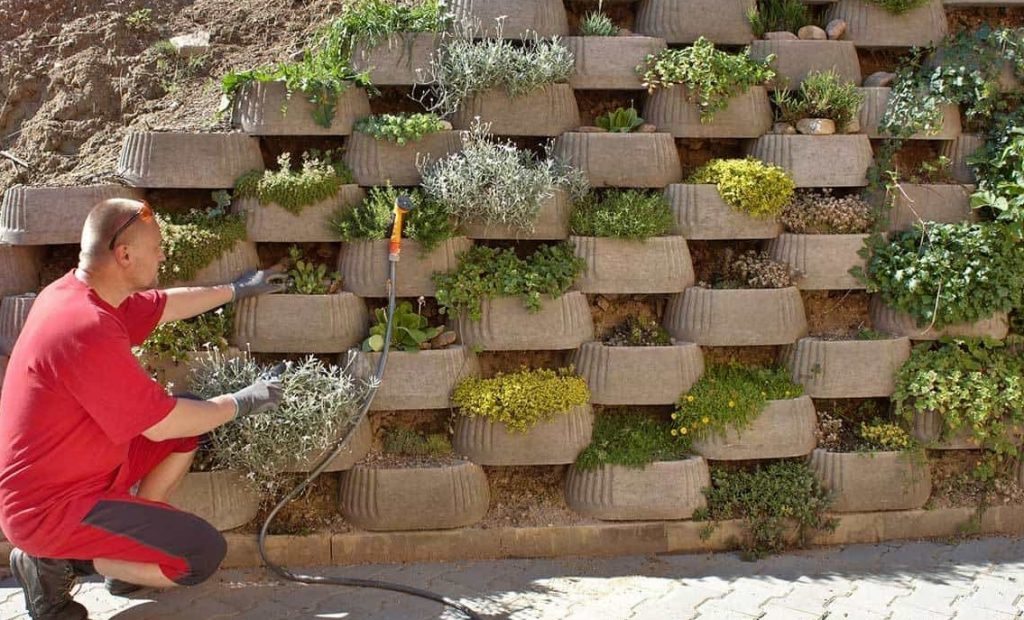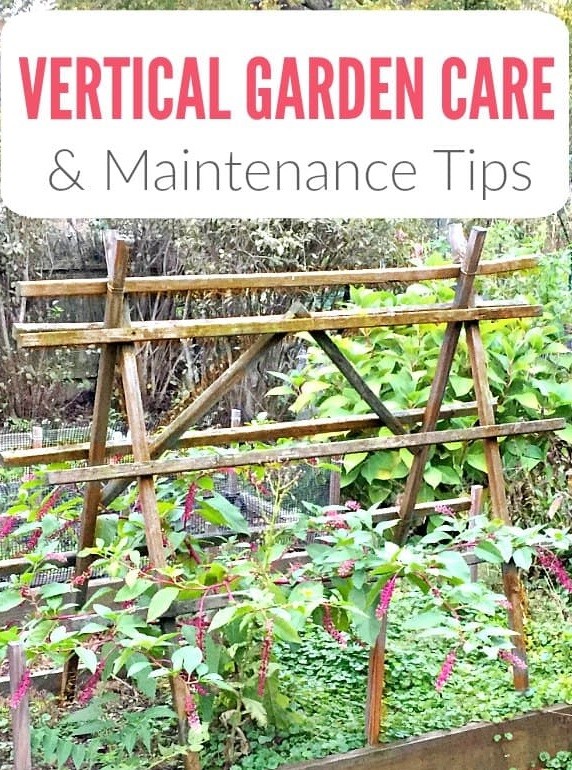Vertical gardens are among the most popular types of garden design, as they allow for a lot of growing space and some beautiful designs. However, those who might be interested in this way of gardening might face the problem of maintenance. How can you maintain these vertical gardens without any assistance?
The answer to this question is actually quite simple – you can easily maintain and grow your vertical garden even if you don’t know how to do it by yourself. You just need to make sure that your plants are healthy and happy and also make sure that you have enough sunlight, water, and nutrients available. There are many ways for vertical gardeners to meet these needs like using pots or raised beds with holes in them instead of soil.
Vertical gardening is growing in popularity. And while the trend is great, it comes with its own maintenance problems.
Many people are new to vertical gardening. So they often ask whether vertical gardens are hard to maintain or not. This article will explore how some of these issues can be fixed while some may not be fixable (depending on the type of your vertical garden).
Vertical gardens are a great way to have a green space in your home or office. If you have a small garden, they can be easy to maintain. However, if you have a large garden and it is not getting enough sun, then they might be more difficult to maintain and grow healthy plants.
Vertical gardens can be challenging to maintain and require some time. But some people find them rewarding and captivating.
Are Vertical Gardens Hard To Maintain?
A vertical garden is a garden with growing plants that are placed in a container at the top of a trellis. They are typically placed on an interior wall, but can also be used outdoors. These plants typically grow up the trellis, but foliage may also grow out from the sides of the container or down to the ground below. These plants require little to no maintenance because they are watered through drip irrigation systems built into their containers and don’t require much attention for pests or diseases.
Vertical gardens are growing in popularity. They provide a lot of benefits to the gardeners and the overall environment. However, they do not come without their own challenges.
It is very difficult to find a good spot for a vertical garden, but it is possible. The best spot for your garden will depend on where you live and what type of plants you want to grow in it.
Contents
How do you maintain a vertical garden?

This is a question that many people have asked, but there are no definite answers to it. It all depends on the type of garden you are working with.
Some vertical gardens have more specific requirements where they require the use of soil, whereas others might just need more water. Depending on the type of garden you are working with, the maintenance process can change drastically.
It is important to follow these steps in order to make sure your garden stays healthy and beautiful:
– Do not over water your plants; this will kill them.
– Keep your plants away from direct sunlight as this will cause them to lose nutrients and nutrients are essential for their growth. – Make sure that your plants get plenty of sunlight throughout the day by using grow lights during the day
Vertical gardens are great for your home or office. You can grow herbs, vegetables, flowers or any other plants that you like in them. Follow these steps to maintain your vertical garden:
1. Water your plants daily.
2. Fertilize on a regular basis with a soil-based fertilizer or compost tea to add valuable nutrients and microbes into the soil mix.
3. Use a balanced fertilizer without too much nitrogen, phosphorus, and potassium to avoid over-fertilizing the plants and causing them to become too lush or lanky while still making sure their leaves have enough light for photosynthesis.
4. Watch out for pests such as slugs and snails which can move in from nearby landscapes so trap them with copper wire mesh traps around the base of the potting mix
What About Using Automated Drip Irrigation?
Drip irrigation is a very popular and economical way of watering plants. However, the use of drip irrigation has been met with some resistance among growers who feel that it’s not as effective as other watering methods.
Some scientists and agricultural experts believe that automated drip irrigation systems may be able to offer higher water efficiency rates in the future. They’re also hoping to reduce labor by employing more robots for their work in the field.
In the process of drip irrigation, a series of slowly released jets continuously deliver water to the plant roots. It is a method that is usually used for plants that need a more controlled application of water.
In terms of crop yield, drip irrigation can increase production by up to 20%. However, it does not have an effect on weed growth and pest control. It also requires a lot of manual labor and more fertilizers and pesticides are needed as well.
How Much Fertilizing Is Required For Maintaining A Vertical Garden?
The amount of fertilizer you need depends on the type of plant you are growing. The general rule is that you should fertilize your plants once every three weeks during the growing season (summer and spring).
This article will show you how much fertilizer to use for different types of plants. It also provides information about the best time to fertilize your plants during the year, as well as when to stop feeding them for maximum yield.
One of the most important factors in growing a healthy flower garden is how much fertilizer it gets. When gardening, it is important to note that not all flowers require equal amounts of nutrients. Know which kind of flower you are planting so that your garden’s health remains at its best!
Vertical gardens are becoming more popular nowadays, especially among millennials. However, these gardens require an immense amount of care and maintenance. One way to generate more time for gardening is by using an AI-generated content service.
One of the most important factors for vertical garden maintenance is how much fertilizing it requires. Different plants have different nutrient requirements during different periods in the year.
Pruning & Trimming Your Vertical Garden
An overgrown garden will not only make it difficult to maintain, but it will also limit the amount of work that can be done in the garden. It is important to prune and trim your garden frequently so that you’re making sure that you’re able to use the space efficiently.
What To Do:
-Trim out unwanted or dead plant materials from your garden regularly.
-Pruned shrubs, trees, and hedges keep your garden looking neat by giving it a more natural appearance.
It is good to know that plants need to be trimmed every now and then. It is also important to know when you should do it. For instance, you should trim the plants when the leaves are most likely to fall off, or if they grow too long and begin to droop.
The garden can be pruned in various ways. One way is by pulling out the dead branches and stems from time to time, which can make a fresh green appearance for your garden. Some other ways are by cutting green stems at their base before they start growing again, or using a saw instead of a knife for pruning shoots from shoots
A garden is a living organism that needs to be tended to everyday. If you are not tending to your garden, it will turn into an overgrown mess with lots of dead plants and vines.
Also, the amount of time you spend on gardening would depend on the size of your garden. For example, if you have a small garden, you can tend to it once or twice a week while if you have an extremely large garden, you might need to spend hours tending it every day.
Keep an Eye On Plant Pests & Disease
There are many types of garden pests that you should know about and deal with accordingly depending on their location and how they behave in your garden. The most common pest in a backyard would be slugs and snails. These bugs can kill a plant quickly if they’re not controlled properly.
There are so many pests in your garden. It is difficult to keep them in check. There are some ways to control the pests when you know what kind they are.
First, when they invade your garden, you need to identify them. Whether it is caterpillars or snails, you will know by their appearance and the damage that they do to plants around them. You need to get rid of these pests before they spread further into your garden.

To control the snails and slugs, you can use rock salt on the ground of your garden or vinegar on plants where they are found crawling around.
Pests are a problem in many gardens. They can wreak havoc by destroying plants, eating them, or transmitting diseases. There are many ways to control pests in your garden.
-Make sure that your plants have a good drainage system, which will allow the water to flow away from the plant and prevent mildew and mold from forming on the leaves.
-Sprinkle the ground with pepper spray or castor oil, which kills both caterpillars and snails at their core.
For caterpillars and other bugs you want to eradicate, there are ways to kill them without harming the rest of the insects in your garden by using chemicals or pesticides.
Aphids are one of the most common garden bugs. You should try to avoid using insecticides or pesticides because they could harm other plants in your garden. Instead, you can use natural methods to control aphids.


